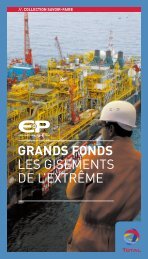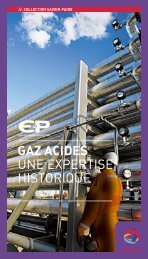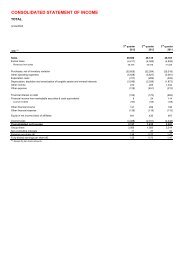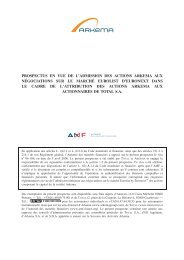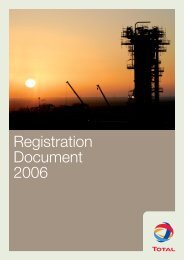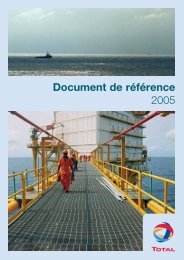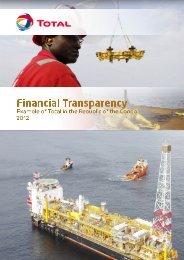Registration Document 2005 - Total.com
Registration Document 2005 - Total.com
Registration Document 2005 - Total.com
You also want an ePaper? Increase the reach of your titles
YUMPU automatically turns print PDFs into web optimized ePapers that Google loves.
Environment<br />
Pursuant to French Law 2001-420 of May 15, 2001, TOTAL S.A.<br />
must provide information regarding the social and environmental<br />
consequences of its activities. Under the implementing decree of<br />
February 20, 2002, this information must include details about the<br />
environmental objectives of its foreign subsidiaries.<br />
The following discussion provides information about the<br />
environmental policy objectives proposed by the parent <strong>com</strong>pany.<br />
More detailed environmental information does not seem relevant<br />
for this discussion, given the nature of the activities of the holding<br />
<strong>com</strong>pany and of the Group.<br />
The TOTAL Group operates projects in over 130 countries, in<br />
areas as diverse as upstream and downstream oil and gas, energy<br />
production and chemicals. The special social and environment<br />
report titled “Sharing Our Energy” provides in the environmental<br />
section detailed information on how the various entities of the<br />
Group conduct their environmental policies. It reports on the<br />
environmental consequences of those activities, describes and<br />
explains their qualitative and quantitative impacts, details the<br />
actions taken and presents the environmental performance of the<br />
entire Group, as well as the <strong>com</strong>mitments that the Group has made<br />
or is planning to make.<br />
The Safety, Environmental and Quality Charter is now a benchmark<br />
in the Group’s corporate culture, and demonstrates its <strong>com</strong>mitment<br />
to operational safety, personal health, environmental protection, and<br />
the quality of its products and services. This Charter, which has<br />
been translated into several languages, must be implemented on<br />
the basis of the operational realities of each of our businesses.<br />
It is based on ten principles, which are explained in a user’s guide<br />
designed to assist managers in implementing those principles in the<br />
performance of their daily duties.<br />
The ten principles are organized into three themes: the industrial<br />
activity itself, employees, and third parties.<br />
• with respect to industrial activity, no development project,<br />
no extension of an industrial unit, no launch of a new product<br />
may be started in any country in which a Group subsidiary<br />
operates without a preliminary and detailed analysis of the safety,<br />
health and environmental risks conducted by the operational<br />
branch in question. Consideration of those risks and the adoption<br />
of the necessary prevention, correction and <strong>com</strong>pensation<br />
measures is verified when the project is reviewed by the business<br />
divisions involved. Major investment, acquisition and disposal<br />
projects are reviewed by the Group Executive Committee<br />
and must first be presented for an opinion to the Group Risk<br />
Committee. This Committee includes a representative from the<br />
Sustainable Development and Environment Department and a<br />
representative from the Industrial Safety Department.<br />
Appendix 3 - TOTAL S.A.<br />
Employment and environmental information<br />
TOTAL - <strong>Registration</strong> <strong>Document</strong> <strong>2005</strong><br />
11<br />
This risk evaluation and prevention procedure is based on<br />
scientific analyses of the substances used and produced and<br />
their effects, environmental impact studies, and technological risk<br />
studies, conducted in accordance with the regulations in force in<br />
the countries where we operate and with industry standards. In<br />
recent years, the Committee has attached increased importance<br />
to analyses involving health risks, and is progressively including in<br />
such analyses the issue of the end of the useful life of products and<br />
facilities. Special attention is also now paid to biological diversity,<br />
particularly in very sensitive ecological zones that have been<br />
identified with the assistance of scientific organizations.<br />
Consideration of these various scientific and technical aspects<br />
in the decision-making process is based on preliminary studies.<br />
Projects to harmonize the methodologies used to conduct these<br />
preliminary studies are currently in progress within the divisions.<br />
After the startup of the project, the evaluation and prevention step<br />
is repeated regularly throughout the project in order to verify that<br />
the environmental impacts and safety risks are as low as possible.<br />
Pursuant to the Safety, Environmental and Quality Charter, the goals<br />
of prevention are to reduce discharges of polluting substances<br />
into the atmosphere and water, to reduce the consumption of<br />
water and certain raw materials, to improve energy efficiency, to<br />
reduce waste production on the sites, and to recycle the wastes<br />
that are produced. In <strong>2005</strong>, each division set certain quantitative<br />
goals to improve its environmental performance, and transposed<br />
them to site-level based on the specific features of each site. The<br />
<strong>com</strong>mitments to reduce greenhouse gas emissions set in 2001<br />
were met in 2004; the establishment in <strong>2005</strong> of the European CO 2<br />
quota trading system is a new step in the policy to fight global<br />
warming, which represents a true technological challenge for<br />
the Group. The reductions in greenhouse gas emissions and the<br />
corresponding actions are described in detail in the aforementioned<br />
social and environmental report by the Group.<br />
Special attention is also paid to soil and underground water<br />
contamination, with special programs to evaluate risks and<br />
clean-up. Studies to coordinate assessment methodologies and<br />
the criteria used to develop cleanup action plans are currently in<br />
progress.<br />
In addition to this prevention policy, each operational entity of the<br />
Group must establish its own resources and emergency response<br />
plans in the event of accidents. These measures are regularly<br />
updated and checked by the relevant Environmental and Safety<br />
departments, and opportunities to share experience are organized<br />
on a regular basis. These policies to prevent and fight the effects<br />
of any accidents are not only applied to industrial sites but also to<br />
the transport of hazardous materials, which is covered by similar<br />
measures and methodologies.<br />
255




